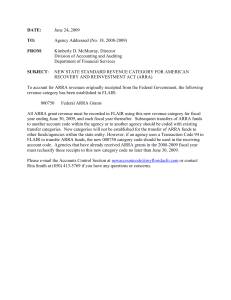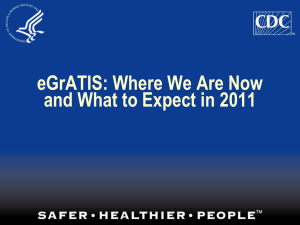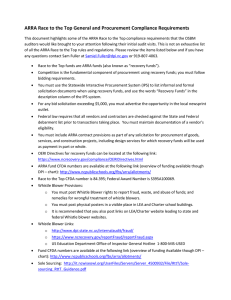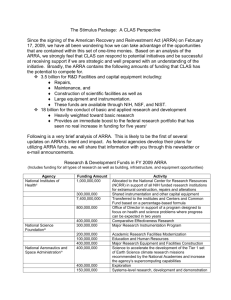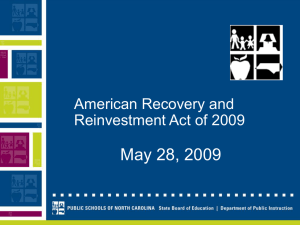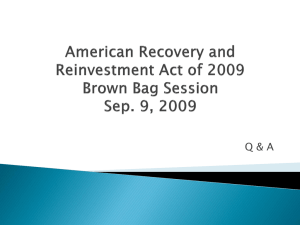Unfunded Mandate-- Does More Money Mean Better Compliance?
advertisement
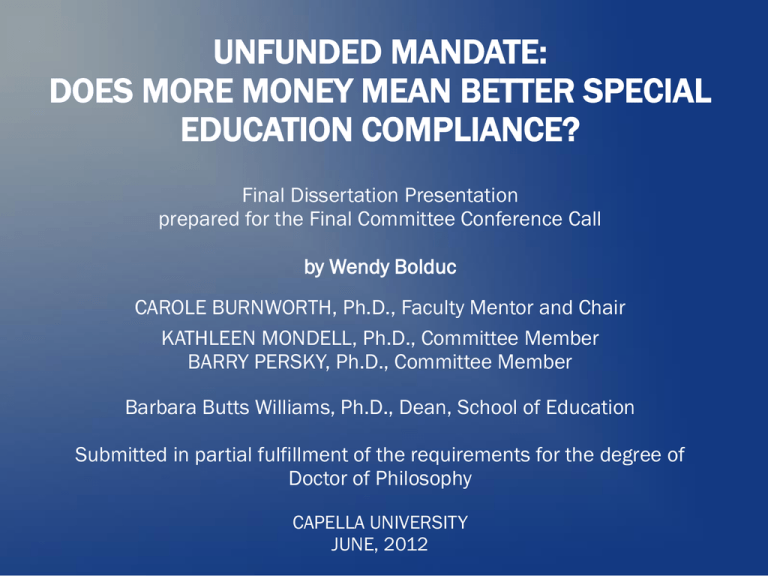
UNFUNDED MANDATE: DOES MORE MONEY MEAN BETTER SPECIAL EDUCATION COMPLIANCE? Final Dissertation Presentation prepared for the Final Committee Conference Call by Wendy Bolduc CAROLE BURNWORTH, Ph.D., Faculty Mentor and Chair KATHLEEN MONDELL, Ph.D., Committee Member BARRY PERSKY, Ph.D., Committee Member Barbara Butts Williams, Ph.D., Dean, School of Education Submitted in partial fulfillment of the requirements for the degree of Doctor of Philosophy CAPELLA UNIVERSITY JUNE, 2012 DEDICATION This effort is dedicated to my parents, who were both lifelong learners. They instilled in me a love of learning and a desire to pursue the truth. They encouraged my endless curiosity, and taught me the value of integrity and self-respect. In memoriam, thank you Mom and Dad. . ACKNOWLEDGMENTS I would like to acknowledge the advice and support of my mentor, Dr. Carole Burnworth, my dissertation committee members, Dr. Kathleen Mondell and Dr. Barry Persky, and my advisor Dr. Jonathan Gehrz throughout this effort. WHY THIS TOPIC WAS SELECTED My experience has been that compliance with IDEA is largely ignored until there is a threat of due process or a loss of funding. I believe that compliance with Part B of IDEA (2004) will produce better educational and life outcomes for students with disabilities and help them to become independent contributors to society rather than make them dependent upon society, WHY TOPIC WAS SELECTED (continued) We have a legal, ethical and moral responsibility to students with disabilities and their families to improve special education programs through improved compliance in order to provide successful educational experiences and life outcomes for these students Beginning with funding levels, determining some of the factors that may impact compliance seemed to be a good starting place to improve RESEARCH QUESTIONS R1 What relationship, if any, exists between per pupil funding for special education as provided through the ARRA stimulus program for Part B of IDEA (2004) and improved special education compliance as measured by the twenty performance indicators reported in state Annual Performance Reports (APRs)? R2: Are there any significant or distinct characteristics that states demonstrating adequate or improved compliance with Part B of IDEA (2004) share? R3 : Are there any significant or distinct characteristics of states demonstrating inadequate or reduced compliance with Part B of IDEA (2004)? MAJOR POINTS OF LITERATURE REVIEW No seminal studies on the relationship of compliance to finance in special education were identified (McLeskey & Landers , 2006) Studies on special education funding and/or compliance were separate ARRA (2009) stimulus program doubled federal special education funding in FFY09 Non-compliance results in high litigation costs to the district, inadequate program outcomes and poor relationships with families in special education MAJOR POINTS OF LITERATURE REVIEW Other factors identified in the literature which may influence compliance: IDEA (2004) and No Child Left Behind (NCLB, 2001) requirements for SWDs Variations in state special education financing methods Current state of the economy causing staffing and program cuts Administrator awareness of special education legal requirements Number of ELL and ESE students RESEARCH METHODS This was a quantitative correlational study using measurable variables. Compliance was first compared to funding, and then to other factors to determine if any were related to compliance RESEARCH METHODS (continued) Compliance for each of the two study years was measured using a calculated compliance rate. The number of indicators for which the state target was met was divided by the number of indicators reported by the state Annual Performance Report (APRs), or from the Office of Special Education’s Response Tables to the states. Funding was measured by the average per pupil (APPE) special education grant amounts. Special education APPEs were calculated from the total federal special education grant amounts to the state divided by the number of special education students served under Part B by the state for each of the two study years. RESEARCH METHODS Compliance rates for states grouped and coded as compliant and non-compliant were compared to the number of Part B special education students served by the state the total number of special education disputes for the state the cost-of-living index AND RESEARCH METHODS (continued) the percentage of students with disabilities relative to school population the percentage of ARRA funds obligated or spent by March 4. 2011 region of the country by performing statistical procedures to compare means, paired samples t-tests, and correlations using Predictive Analysis Statistics GradPack 18 software (PASW-18). RESEARCH QUESTION 1 RESULTS R1 : Is there a relationship between increased funding and compliance? NO No relationship between funding levels and compliance for either study year was found There is a 91.7% probability that differences in the two years can be attributed to chance The null hypothesis must be accepted for research question one. RESEARCH QUESTION 2 RESULTS R2: Do states showing adequate or improved compliance share significant or distinct characteristics? YES States with smaller special education populations lower numbers of special education disputes location in the Central Plains, Southwest, West, Northwest and Pacific regions were more likely to show higher compliance rates for both study years. RESEARCH QUESTION 3 RESULTS R3 : Do states showing reduced or inadequate compliance rates share significant or distinct characteristics? YES States with larger special education populations with more special education disputes located in the Northeast, Mid-Atlantic, Appalachia, Southeast, and Midwest regions were more likely to have lower compliance rates for both study years ADDITIONAL RESULTS The percentage of students relative to the total school population identified as disabled and needing special education services was not found to be significantly related to compliance rates The cost-of-living index for FFY09 showed a weak inverse relationship to compliance rates for FFY09 The percentage of ARRA money obligated or spent as of March 4, 2011 was not found to be significantly related to compliance rates IMPLICATIONS FOR PRACTICE States with large special education populations might consider ways to break their special education populations into smaller subgroups States should focus on reducing the total number of special education students, not percentages High levels of poverty and large numbers of ELLs tend to produce larger numbers of students in special education programs (Baker & Ramsey, 2010) so districts should attempt to further address ways to minimize the effects of these IMPLICATIONS FOR PRACTICE (continued) States should attempt to reduce the number of complaints they experience (whether settled, withdrawn or dismissed) by analyzing the types and numbers of complaints to pinpoint areas of improvement on which to focus Encouraging the development of positive relationships with the parents of students with disabilities has been suggested in recent literature as a way to reduce the number of complaints (Diliberto & Brewer, 2012). RECOMMENDATIONS FOR FURTHER RESEARCH Further study into compliance rates and ARRA funding for FFY10 is indicated Long-term effects of programs funded through ARRA should be examined The point at which the number of special education disputes and the number of special education students begin to adversely affect compliance should be examined RECOMMENDATIONS FOR FURTHER RESEARCH (continued) Why region of the country appears to be a factor in compliance should be studied The performance indicator targets should be examined more closely for consistency across states. Meeting the target in one state can mean something entirely different from meeting the target in another. CONCLUSIONS Whether inadequate funding is the cause of states’ failure to fully comply with IDEA has not been settled by this study The study’s results can contribute to the conversation about the relationship between funding and compliance and has identified other factors which may be as important if not more important than funding in states’ efforts to be fully compliant with IDEA requirements CONCLUSIONS (continued) We have a legal, ethical and a moral responsibility to provide students with disabilities with a free, appropriate public education in the least restrictive environment and in so doing improve their educational and life outcomes Full compliance with IDEA can help to ensure that this becomes a reality. The futures of students with disabilities, and their successful transition into society when their schooling has ended depend upon it.
